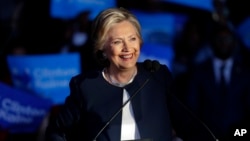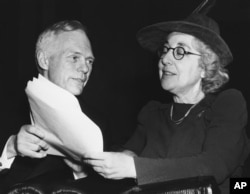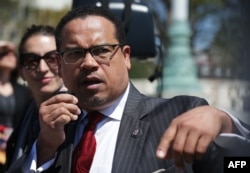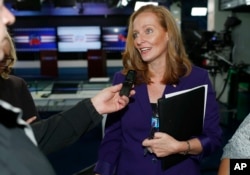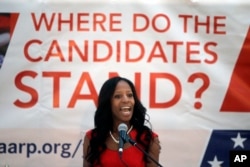On Election Day, American voters could elect the first female president to follow the nation's first African-American president.
But even with those historic firsts in the White House and an expected rise in the number of woman and minorities elected to the U.S. Congress this year, the nation's highest elected offices still don't reflect the demographic diversity of the nation.
One in five members of the current Congress is part of a racial or ethnic minority, according to a 2015 Pew Research Center analysis, making for the most diverse Congress in history. But that study also found the nation's highest elected legislative body is still disproportionately white and male when compared to the actual demographics of the country.
"We are not looking at really any of our elected offices from local government on up as representative of the population as a whole," says Debbie Walsh, director for the Center for American Women and Politics at Rutgers University. "At no level of elected office, do we have more than a quarter of the office-holders are female."
Exactly 100 years after Republican Jeanette Rankin became the first female elected to the U.S. Congress, women are still working for proportional representation.
The number of women in the U.S. Senate could increase to as many as 22 seats in this year's election, and women could net a gain of up to five seats in the House of Representatives, according to an analysis by Walsh.
Racial and ethnic minorities also face a long road toward proportional representation, says Sayu Bhojwani, founder and president of the New American Leaders Project, an organization advocating for a more inclusive democracy.
"The representation gap is so great that what we're mostly seeing is an incremental change, along with a few historic candidates," she says.
Those historic firsts could include the first Latina woman in the U.S. Senate, possibly the first Indian-American in the House of Representatives and a growing trend of more American Muslim candidates.
Demographic strategies
As the numbers of women and minorities slowly increase, candidates in close Congressional races across the country are learning to craft their messages to the changing demographics of the electorate.
Redistricting in 2011 resulted in a change in the electorate in Colorado's 6th Congressional District, boosting the number of Latino voters and pushing the immigration issue to the forefront for Democratic challenger Morgan Carroll.
"We've seen a very significant demographic shift in this district," Carroll told VOA at a halfway house for undocumented immigrants in Aurora, Colorado. "The Latino population among many others are an extremely powerful voting bloc and can and will make a difference and decide the outcome of this election."
Carroll has hit her opponent, Mike Coffman, hard on his inconsistencies on immigration issues, arguing he shares policy approaches in common with his Republican ticket-mate Donald Trump even though Coffman has made a point of not endorsing him.
Carroll is employing a strategy used by many female Democratic candidates this election season against their male Republican opponents, Walsh says.
"More than using gender what we're seeing is using the hot potato of Donald Trump as the issue," she says. "Some of these women candidates have been calling out their opponent if they haven't distanced themselves from Donald Trump."
At her campaign headquarters in Florida's 7th Congressional District, first-time Democratic candidate Stephanie Murphy told VOA her opponent Congressman John Mica's support of Trump could be a problem with voters.
Murphy's campaign ads have linked Mica's voting record on women's health issues with Trump's controversial statements about women.
The Florida 7th was redistricted to include a much more diverse population that could be attracted to voting for first-generation Vietnamese-American Murphy.
Looking ahead
First-generation minority candidates can face significant barriers to election to national office, Bhojwani says. The representation gap for minorities is even greater at the state legislative level than it is for the U.S. Congress and "so the pipeline of potential national candidates isn't as strong."
She says both political parties need to do a better job of recruiting and supporting more diverse candidates and "when more diverse Americans see themselves reflected in government, they are more likely to feel that the political process and government more broadly are institutions with which they can engage."
For now, the election of more female senators could play a key role in tipping the party balance in the next Congress.
"If Democrats are to re-take the Senate, it will be in large part whether or not these women win and if the Democrats do take control," Walsh says. "It won't just be us seeing an increase in the number of women, it will be an increase in women's leadership within the Senate."
Ultimately, the placement of more women in leadership roles in the senate could translate into more women running for president down the road. The U.S. severely lags behind most developed nations in terms of women's representation in national legislatures and as heads of states.
Walsh notes that shouldn't detract from another longer-term problem in our political system that could prevent many female candidates from even thinking about running.
"The ways we're seeing gridlock at the Congressional level has been a real deterrent for women running for office," Walsh says. "They want to get something done about an issue, and they may well look to government and say well, Washington isn't the place to go."
